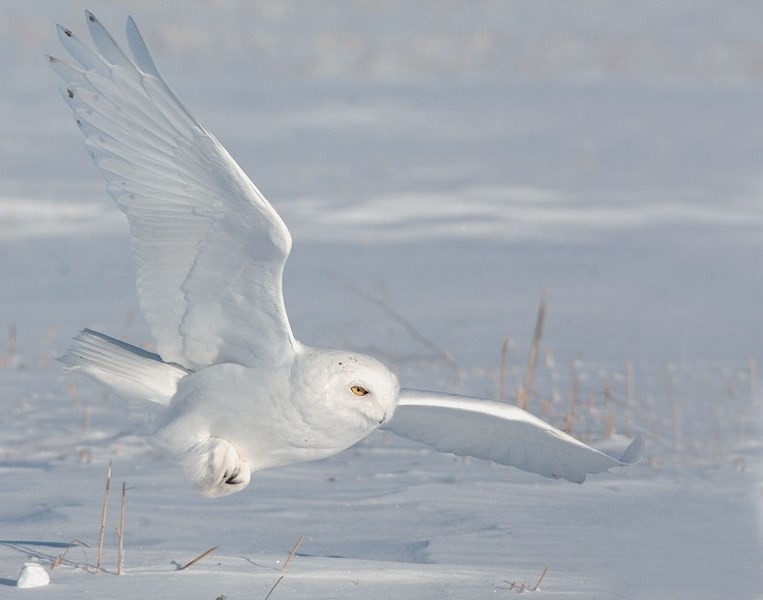I have a bad habit of looking up while driving along Campbell Road. My eyes should be on the road, but I can't help but watch the skies in hopes of spotting one of winter's biggest birds: the snowy owl.
I have a bad habit of looking up while driving along Campbell Road.
My eyes should be on the road, but I can't help but watch the skies in hopes of spotting one of winter's biggest birds: the snowy owl. More often than not, I'll spy one perched high atop a lamppost, a silent sentinel, sweeping its head back and forth in search of suspicious activity.
Snowy owls are large white birds that are often spotted atop lampposts and power poles, says Gordon Court, a wildlife status biologist with Alberta Fish and Wildlife. Males are snow white, while females and juveniles are white with brown bars.
Unlike some owls, Court continues, snowy owls have very small ears, making for a very round head, and they're active day and night.
Snowy owl numbers change wildly from year to year, Court notes, as they depend on the unpredictable lemming population in their Arctic breeding grounds. "This year is a terrific year for the snowy owl," he says, and you can easily spot two or three in a half hour by driving north of St. Albert.
About five snowy owls were spotted during the recent Christmas Bird Count. One has been hanging around the Enjoy Centre this winter, and another is camped out around Campbell Road.
They're easy to find if you look, says local birder Alan Hingston. "They make no attempt to hide themselves," he says, and you can often spot them 500 metres away. Check the top of high posts or hay bales, he suggests, particularly along gravel roads north and west of St. Albert.
The snowy owl's white feathers camouflage it against the snow up north, Court says. Those feathers also have frayed, comb-like edges to cut down on noise, allowing the owls to swoop in on their prey with nary a sound despite its almost 1.5 metre wingspan.
They also have a lot of feathers – about 35,000, Court says, covering everything but their beak, plus a thick layer of down. This excellent insulation lets the owls weather -50 C temperatures, says Hinterland Who's Who, and makes them the heaviest owl in North America. (The birds look vaguely spherical when they fluff up, Court adds.)
All those feathers are a hassle when it's hot, however. You'll often see snowy owls cooling off on frozen lakes during the spring for this reason, Court says.
Snowy owls are powerful animals, Court says, capable of killing anything smaller than a jackrabbit with their 35-millimetre long talons. They rely mainly on their sight to hunt, and constantly scan the horizon for targets – their eyes don't move in their sockets, so they twist their heads instead.
Bird-bander Hardy Pletz has witnessed what happens next many times. As soon as the owls spot any movement – a vole poking its head out of the snow, for example – they'll come in low and fast, wings pumping, and try to snatch their prey on a fly-by. "If they do get the prey, they'll swallow it whole." He's seen snowy owls catch and eat as many as eight voles in two hours.
The birds are very quiet at this time of year, Pletz says, and don't make many calls unless a rival invades their turf. But if one does, watch out – the birds will charge at each other, lock talons in mid-air, and snap at and harass each other until one of them retreats.
Many are exceptionally long-lived. Pletz says he caught a snowy owl in January that he had personally banded in roughly the same spot in 1994. That suggests the bird may have been 21 years old – much older than the previous record of 16.
Snowy owls are of no risk to the public, Pletz says, but the public is a risk to them. "They're out there now in the daylight to collect food," he says, and if you're chasing them for a picture, they're not eating. "Leave yourself some distance," he says, and don't follow the birds if they leave.
The Edmonton Nature Club is holding a Snowy Owl Prowl this Feb. 16 for anyone who wishes to see these birds up close. Call Hingston at 780-459-6389 for details.
Snowy owl
Name:<br />Bubo scandiacus.<br />
Appearance: <br />Huge white owl, possibly with brown/black stripes, with a smooth round head, feathered legs and no ear tufts.<br />
Commonly seen:<br />Perched atop lampposts, looking around.<br />
Occasionally confused with: <br />Barn owls, which are smaller, nocturnal and more brown.<br />
Fun fact:<br />They can eat about 1,600 lemmings a year.
Wild St. Albert
Like wildlife? So do we! Every second Wednesday the Gazette profiles a reasonably common wild creature in the St. Albert region. Birds, beasts, bugs, fish … so long as it's alive and kicking, we'll feature it. <br /><br />Got a creature you'd like to see profiled? Send your suggestions to [email protected].




